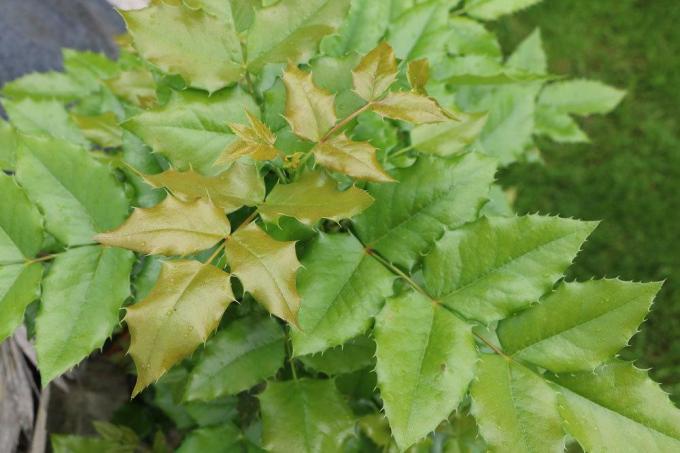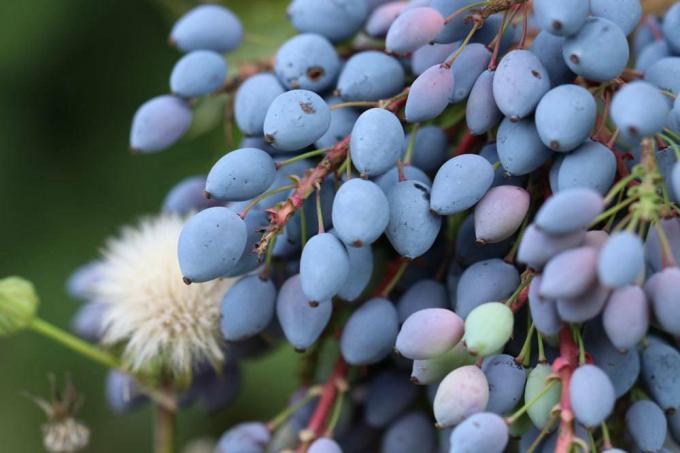
table of contents
- Toxicity
- Poisonous effect
- For animals
- Toxin
- consumption
- edibility
- Berry
- root
There are around 70 different species of Mahonia around the world, the specimens that live here reach a height of up to one meter. They are evergreen plants with pinnate leaves on which spherical, very acidic berries grow.
Toxicity
How poisonous is the Oregon grape?
In general, the Oregon grape is considered to be slightly toxic, but different parts of the plant have different effects. While the fruits lead to diarrhea and other gastro-internal side effects when consumed, the bark and roots of the plant cause disturbances of consciousness.
As a rule, however, only small children are at risk; adults hardly or rarely react to the consumption of parts of the plant. Oregon grape, on the other hand, is poisonous for pets and in the worst case scenario can even be fatal. If a child ingests larger amounts of the plant, more severe symptoms may arise that require medical attention.
Poisonous effect
When consuming fruits, these include:
- nausea
- Vomit
- diarrhea
- Sweats
- Abdominal pain and colic

When eating bark and roots, the following symptoms can occur:
- Dizziness
- headache
- Drowsiness
- Limitations of Consciousness
The symptoms do not have to occur, the risk increases with the amount of plant parts consumed.
For animals
Toxicity of Mahonia in animals
Oregon grape is particularly poisonous for small animals such as guinea pigs, rabbits and hamsters. If parts of the plant are eaten, the small animal can suffer from significant symptoms. Most of the time, gastro-internal disorders occur, but consciousness can also be clouded. There is also a small risk of long-term kidney damage, but only if high doses have been consumed.
Toxin
Consuming the root is more dangerous than consuming the berries. It contains alkaloids, which are also found in barberries. What can even show beneficial effects for humans when used correctly is a harmful poison in the animal world.

consumption
What to do if parts of the plant are accidentally eaten?
Adults need not worry if small parts of an Oregon grape are accidentally eaten. Although the roots in particular are slightly poisonous, the amount ingested would have to be disproportionately large for dangerous symptoms of poisoning.
children
In the case of children, it is advisable to alert the medical emergency service, as the small organism is not yet able to break down the toxins well. When eating berries, help is limited to relieving symptoms. Diarrhea and nausea with vomiting are relieved with medication, and the poisoning is usually over after 48 hours.
If, on the other hand, a child has consumed large amounts of the plant roots or parts of the bark, the body is detoxified under medical supervision. In the worst case, gastric lavage may be necessary to get the harmful substances out of the body as quickly as possible. In any case, the administration of fluids is necessary.
animals
Animals usually suffer worse symptoms of poisoning, which can lead to death in small animals such as rabbits, guinea pigs and hamsters. Cats and dogs usually survive Mahonia poisoning unscathed and suffer the same symptoms as a small child.
For the safety of the pet owner, it is always advisable to consult a veterinarian and to coordinate the further procedure with him. In cats and dogs, small amounts of Mahonia usually do not cause any symptoms, rodents, on the other hand, can show severe symptoms of intoxication up to delirium.

edibility
Mahonia suitable for consumption?
The North American natives use Mahonia as a medicinal plant. There are various areas of application, especially gastrointestinal disorders such as constipation are treated with the berries.
Berry
The sour berries are a wholesome laxative when consumed in small quantities. Larger amounts lead to severe diarrhea. The fruits are either consumed raw or cooked beforehand. It is also possible to make jam. They can be dried to use them all year round. Their high vitamin C content makes them a healthy change on the menu.
root
Tea can be brewed from the roots and bark of Mahonia, which counteracts indigestion. The tea is also said to provide a stronger immune system and stimulate kidney function. Sore throat and throat discomfort can be relieved if the tea is used to gargle. If a tincture is made from the root, it can be used against skin irritations and diseases of the upper layer of the skin. Eczema, which responds well to treatment with Mahonia extract, should be mentioned here in particular.
In North American medicine, Mahonia is said to have anti-tumor effects, but this has not been scientifically proven. Oregon grape is also regularly used in homeopathy, but in extremely small doses.
Sources:
http://www.gizbonn.de/184.0.html
https://www.botanikus.de/Beeren/Mahonie/mahonie.html
http://www.heilkraeuter.de/lexikon/mahonie.htm



